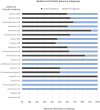Analysis of umbilical cord tissue as an indicator of in utero exposure to toxic adulterating substances
- PMID: 37025298
- PMCID: PMC10070803
- DOI: 10.3389/fped.2023.1127020
Analysis of umbilical cord tissue as an indicator of in utero exposure to toxic adulterating substances
Abstract
In utero drug exposure is a significant public health threat to the well-being and normal development of the neonate. Recently, testing of umbilical cord tissue (UCT) has been employed to measure illicit drug exposure, as drugs used by the mother during the third trimester may be retained in the UCT. Focus has also been given to potential adverse health effects among drug users, resulting from exposure to pharmacologically active adulterants and cutting agents in the street drug supply. The in utero effects of these substances have not been well studied in humans, nor has their presence been demonstrated as a means for assessing adverse health effects in the neonate. Here, we describe the application of a novel test method to analyze UCT for the presence of more than 20 common adulterating/cutting substances via LC/Q-TOF. In total, 300 de-identified UCT samples were analyzed-all had previously tested positive for cocaine or opiates. Generally, the positivity rates of individual compounds were similar between the Cocaine and Opiates Subgroups, apart from levamisole, xylazine, dipyrone (metabolites), and promethazine. Many of the adulterants used in the street drug supply do have legitimate medicinal/therapeutic uses, including several of the compounds most frequently detected in this study. Caffeine and lidocaine were the most frequently identified compounds both individually (>70% each) and in combination with each other. Alternatively, levamisole, an adulterant with no legitimate therapeutic use, was present in 12% of cases. Importantly, this data demonstrates that the detection of traditional drugs of abuse may serve as indicators of potential in utero exposure to toxic adulterating substances during gestation. While there is cause for concern with respect to any unintentional drug exposure, illicit drug use during pregnancy, including uncontrolled dosing, poly-adulterant consumption, and the interactions of these drug mixtures, produces a significant public health threat to the neonate which warrants further study.
Keywords: adulterant; dipyrone; levamisole; neonate; phenacetin; umbilical cord; xylazine.
© 2023 Midthun, Nelson, Strathmann, Browne and Logan.
Conflict of interest statement
At the time of this study, authors KM, BN, FS and BL are/were employed by NMS Labs. At the time of publication, author FS is employed by MOBILion Systems, Inc. Remaining author TB declares that the research was conducted in the absence of any commercial or financial relationships that could be construed as a potential conflict of interest.
Figures




Similar articles
-
Qualitative LC-Q-TOF Analysis of Umbilical Cord Tissue via Data-Dependent Acquisition as an Indicator of In Utero Exposure to Toxic Adulterating Substances.J Anal Toxicol. 2022 Jul 14;46(6):619-624. doi: 10.1093/jat/bkab094. J Anal Toxicol. 2022. PMID: 34592760
-
Levamisole-a Toxic Adulterant in Illicit Drug Preparations: a Review.Ther Drug Monit. 2021 Apr 1;43(2):221-228. doi: 10.1097/FTD.0000000000000851. Ther Drug Monit. 2021. PMID: 33298746 Review.
-
Analysis of cocaine adulterants in human brain in cases of drug-related death.Forensic Sci Int. 2018 Apr;285:86-92. doi: 10.1016/j.forsciint.2018.02.001. Epub 2018 Feb 10. Forensic Sci Int. 2018. PMID: 29454838
-
Using umbilical cord tissue to detect fetal exposure to illicit drugs: a multicentered study in Utah and New Jersey.J Perinatol. 2008 Nov;28(11):750-3. doi: 10.1038/jp.2008.97. Epub 2008 Jul 3. J Perinatol. 2008. PMID: 18596707
-
Adulteration Practices of Psychoactive Illicit Drugs: An Updated Review.Curr Pharm Biotechnol. 2017;18(7):524-530. doi: 10.2174/1389201018666170710184531. Curr Pharm Biotechnol. 2017. PMID: 28699480 Review.
Cited by
-
Xylazine Use in Pregnancy: The Effects of the Fentanyl Adulterant Xylazine on Pregnant Patients and the Developing Fetus.Kans J Med. 2023 Oct 30;16(3):277-279. doi: 10.17161/kjm.vol16.20624. eCollection 2023. Kans J Med. 2023. PMID: 37954882 Free PMC article. Review.
-
Implications of xylazine exposure in pregnancy: a narrative review.J Addict Dis. 2024 Aug 21:1-8. doi: 10.1080/10550887.2024.2391156. Online ahead of print. J Addict Dis. 2024. PMID: 39166266
References
-
- Substance Use During Pregnancy. Guttmacher Inst (2023) https://www.guttmacher.org/state-policy/explore/substance-use-during-pre... [Accessed February 8, 2023]
LinkOut - more resources
Full Text Sources

